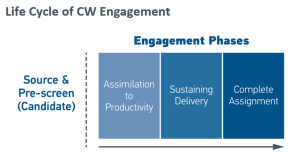During a recent CCWP Certification Class, we discussed the use of assimilation survey tools to measure the early engagement productivity of staff augmentation assignments. In an age where survey fatigue is prevalent in both our professional and personal lives, a survey instrument with a precise, critical purpose could provide critical management visibility.
 The performance lifecycle of a contingent workforce engagement has multiple phases into which program stakeholders need visibility to produce the level of service quality level required by engagement managers. In most cases, CW programs might engage a satisfaction survey tool at the completion of the CW engagement. But few have any visibility of the earlier phases unless the engagement manager raises an issue (positive or negative) to the attention of the CW program office. Too often, the engagement manager actually accepts the poor level of service during the course of the engagement, only to share their disappointment at the completion — if ever. This hidden dissatisfaction is a nightmare for the CW program.
The performance lifecycle of a contingent workforce engagement has multiple phases into which program stakeholders need visibility to produce the level of service quality level required by engagement managers. In most cases, CW programs might engage a satisfaction survey tool at the completion of the CW engagement. But few have any visibility of the earlier phases unless the engagement manager raises an issue (positive or negative) to the attention of the CW program office. Too often, the engagement manager actually accepts the poor level of service during the course of the engagement, only to share their disappointment at the completion — if ever. This hidden dissatisfaction is a nightmare for the CW program.
An assimilation survey tool might offer creative and purposeful visibility into a critical phase of a staff augmentation engagement. These tools have been around for quite some time and are used routinely in RPO workforce solution engagements. In an RPO solution, it is critical to understand that a worker is meeting the requirements and expectations of the hiring manager. After all, this transaction is going to be a long-term placement. Hence, the survey in an RPO application will be deployed multiple times over a six-month period. For a contingent workforce application, the time frame is shorter and the need for “speed to productivity” is fairly quick. So, deployment of a CW assimilation survey tool might take place within a week to 10 days of the start date. Of course, some engagements might have longer assimilation-to-productivity periods, such IT and engineering assignments; hence, the surveys might be deployed at a later timeframe when appropriate.
These surveys are short and to the point, asking two to four questions at the most to measure satisfaction levels with skills provided, gauging whether any unnecessary training was required and the timing of the required productivity level deployed. The tool should be constructed so the engagement manager can respond within a minute or so and might even be set up as an automated mandatory process step to complete a first payroll approval. Survey execution can be capably managed by an MSP solution partner, which can also analyze the service quality data captured.
Certainly, it is important to know whether your contingent workers are delivering the quality expected by the stakeholders. It’s one thing when an engagement manager accepts service that does not perfectly meet their level of quality expectations, but another when unacceptable placements are taking place in a CW program’s service delivery. This kind of initial visibility can lead to quick tactical action in resolving an engagement manager’s initial challenge with a deployed talent service but also potentially give an early warning signal to potential failure modes emerging in the CW program’s service delivery process or emerging weakness in one of the program’s service delivery partner’s performance capability. Waiting for poor satisfaction visibility at the end of a CW placement is obviously too late to mitigate the problem.









